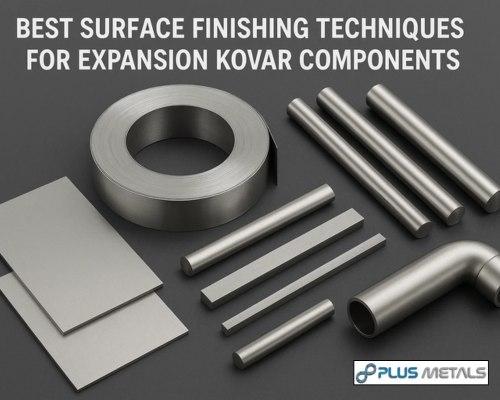Expansion Kovar is a unique iron–nickel–cobalt alloy known for its controlled coefficient of thermal expansion. It is widely used in electronic packaging, hermetic sealing, medical devices, aerospace sensors, and precision engineering components. Because these parts often have extremely tight tolerances and demanding performance conditions, the quality of surface finishing becomes just as important as the alloy itself.
In industries where even micro-level defects can cause failure, choosing the Best Surface Finishing Techniques for Expansion Kovar Components ensures superior functionality, corrosion resistance, and long-term stability. At Plus Metals, we supply high-quality Expansion Kovar raw materials that are suitable for machining, fabrication, and advanced finishing requirements.
Why Surface Finishing Is Essential for Kovar Components
Expansion Kovar is generally used in high-vacuum, high-temperature, or sensitive electrical environments. Surface finishing helps in:
- Removing machining marks and micro-burrs
- Improving dimensional accuracy
- Increasing solderability and bond strength
- Enhancing corrosion resistance
- Reducing outgassing in vacuum applications
- Achieving smooth and uniform sealing surfaces
Since Kovar is used for glass-to-metal and ceramic-to-metal sealing, achieving a clean, contaminant-free surface is critical for bonding reliability. This makes the Best Surface Finishing Techniques for Expansion Kovar Components essential in production cycles.
1. Mechanical Polishing
Mechanical polishing is used to refine the surface and remove irregularities.
Why it works for Kovar:
- Eliminates scratches and burrs after machining
- Suitable for flat and round surfaces
- Ideal for vacuum and optical device components
Various abrasives like silicon carbide, diamond paste, or alumina powders may be used depending on the end finish required.
2. Chemical Etching
Chemical etching is commonly used to clean, dissolve, or brighten the surface of Expansion Kovar.
Benefits:
- Removes oxide layers
- Improves bonding and surface energy
- Prepares surfaces for plating
- Achieves micro-level precision
Typical etching solutions may include hydrochloric acid, nitric acid blends, or proprietary mixtures. Controlled etching avoids excessive material removal.
3. Electroplating
Electroplating is one of the most preferred finishing methods for Expansion Kovar.
Common plating finishes:
- Nickel plating for corrosion resistance and solderability
- Gold plating for high conductivity and oxidation protection
- Tin plating for soldering applications
Electroplating provides strong adhesion when done after chemical cleaning. This process is especially used in electronic packages, connectors, and microelectronic parts.
4. Passivation
Passivation is used to remove free iron and enhance corrosion resistance.
Why passivation is important:
- Stabilizes the alloy surface
- Removes contaminants that affect sealing
- Improves long-term durability
It usually involves nitric or citric acid solutions. For applications in aerospace and defense, passivation becomes a standard requirement.
5. Vacuum Furnace Heat Treatment
While heat treatment is not a typical “finishing” method, it helps in conditioning the surface for better sealing and bonding.
Advantages:
- Reduces internal stresses
- Enhances surface stability
- Prevents contamination during high-temperature operations
Vacuum annealing is often used before plating or sealing operations.
6. Ultrasonic Cleaning
Ultrasonic cleaning removes micro-contaminants that cannot be eliminated by manual cleaning.
Benefits:
- Completely removes dust, oils, and polishing residues.
- Vital for hermetic sealing applications
- Prepares the surface for bonding and electroplating
This is a mandatory step for electronic and medical-grade Kovar components.
7. Laser Finishing
Laser surface finishing is an advanced technique used where precision is crucial.
Benefits:
- Achieves excellent surface uniformity
- Reduces micro-cracks
- Ideal for aerospace, defense, and micro-electronics applications
Laser finishing offers high repeatability and is widely used in critical components.
Conclusion
Selecting the Best Surface Finishing Techniques for Expansion Kovar Components depends on performance requirements. Mechanical polishing, chemical etching, electroplating, passivation, ultrasonic cleaning, and laser finishing all ensure superior reliability and durability.
Plus Metals supplies high-grade Expansion Kovar materials suitable for all finishing techniques used in electronics, aerospace, medical devices, and precision engineering.
For more information, visit:
Plus Metals – Expansion Kovar Products
Expansion Kovar
FAQs
1. Why is surface finishing important for Expansion Kovar?
Surface finishing improves bonding, sealing capability, corrosion resistance, and dimensional stability—all essential for high-precision applications.
2. Which finishing method improves solderability the most?
Nickel or tin electroplating provides the best solderability for Kovar components.
3. Can Expansion Kovar be gold-plated?
Yes. Gold plating is often used in electronics for enhanced conductivity and oxidation resistance.
4. Does Kovar require special cleaning?
Yes. Ultrasonic cleaning is recommended because it removes microscopic contaminants crucial for hermetic sealing.
5. What industries rely most on Kovar finishing?
Electronics, aerospace, medical devices, vacuum technology, and defense manufacturing.

